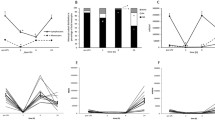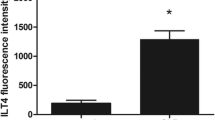Abstract
Background
This study is to investigate the time-course expression of TLR2 and TLR4 on peripheral monocytes in patients receiving major abdominal surgical operation.
Methods
Blood samples were obtained from peripheral vein before and after an operation in 30 patients with gastrointestinal or pancreatic surgery. The mRNA expression of TLR2, TLR4, TNF-α and IL-6 on peripheral blood mononuclear cells (PBMC) was analyzed by real-time PCR. The expressions of TLR2, TLR4, HLA-DR, CD80, and CD86 on monocytes were analyzed by flow cytometry. The expressions of TLR2 and TLR4 on monocytes responding to each agonist (zymosan and lipopolysaccharide) were also measured by flow cytometry.
Results
TLR2 and TLR4 mRNA showed significant up-regulation after the completion of the operation when compared with those before the operation. TLR2 expression reached its peak level on day 1 and TLR4 on days 1 and 3. There was no significant difference between pre- and post-operation in the expressions of HLA-DR, CD80 and CD86. Stimulation with zymosan, increased the expression of TLR2 significantly after the operation and reached its highest value on day 3. Similarly, after stimulation with lipopolysaccharide, the expression of TLR4 was also increased and the highest level was observed on day 1. The expression of TNF-α and IL-6 mRNA decreased after completion of the operation and gradually returned to basal level.
Conclusions
The expressions of TLR2 and TLR4 on monocytes were up-regulated during the early period after a major abdominal surgical operation in patients, which might be related to the activation of innate immunity.





Similar content being viewed by others
References
Wang SY, Mak KL, Chen LY, et al. Heterogeneity of human blood monocyte: two subpopulations with different sizes, phenotypes and functions. Immunology. 1992;77:298–303.
Fingerle-Rowson G, Angstwurm M, Andreesen R, et al. Selective depletion of CD14+ CD16+ monocytes by glucocorticoid therapy. Clin Exp Immunol. 1998;112:501–506.
Wang JE, Dahle MK, Yndestad A, et al. Peptidoglycan of Staphylococcus aureus causes inflammation and organ injury in the rat. Crit Care Med. 2004;32:546–552.
Wright SD, Ramos RA, Tobias PS, et al. CD14, a receptor for complexes of lipopolysaccharide (LPS) and LPS binding protein. Science. 1990;249:1431–1433.
Jiang Q, Akashi S, Miyake K, et al. Lipopolysaccharide induces physical proximity between CD14 and toll-like receptor 4 (TLR4) prior to nuclear translocation of NF-kappa B. J Immunol. 2000;165:3541–3544.
Schwandner R, Dziarski R, Wesche H, et al. Peptidoglycan- and lipoteichoic acid-induced cell activation is mediated by toll-like receptor 2. J Biol Chem. 1999;274:17406–17409.
Beutler B, Hoebe K, Du X, et al. How we detect microbes and respond to them: the Toll-like receptors and their transducers. J Leukoc Biol. 2003;74:479–485.
Takeda K, Kaisho T, Akira S. Toll-like receptors. Annu Rev Immunol. 2003;21:335–376.
Chernow B, Alexander HR, Smallridge RC, Thompson WR, et al. Hormonal responses to graded surgical stress. Arch Intern Med. 1987;147:1273–1278.
Hornung V, Rothenfusser S, Britsch S, et al. Quantitative expression of toll-like receptor 1–10 mRNA in cellular subsets of human peripheral blood mononuclear cells and sensitivity to CpG oligodeoxynucleotides. J Immunol. 2002;168:4531–4537.
Tsujimoto H, Ono S, Majima T, et al. Differential toll-like receptor expression after ex vivo lipopolysaccharide exposure in patients with sepsis and following surgical stress. Clin Immunol. 2006;119:180–187.
Buttenschoen K, Schneider ME, Utz K, et al. Effect of major abdominal surgery on endotoxin release and expression of Toll-like receptors 2/4. Langenbecks Arch Surg. 2009;394:293–302.
Fingerle-Rowson G, Auers J, Kreuzer E, et al. Down-regulation of surface monocyte lipopolysaccharide-receptor CD14 in patients on cardiopulmonary bypass undergoing aorta-coronary bypass operation. J Thorac Cardiovasc Surg. 1998;115:1172–1178.
Volk H-D, Reinke P, Döcke W-D. Clinical aspects: from systemic inflammation to ‘immunoparalysis’. Chem Immunol. 2000;74:162–177.
Dybdahl B, Wahba A, Lien E, et al. Inflammatory response after open heart surgery: release of heat-shock protein 70 and signaling through toll-like receptor-4. Circulation. 2002;105:685–690.
Ikushima H, Nishida T, Takeda K, et al. Expression of Toll-like receptors 2 and 4 is downregulated after operation. Surgery. 2004;135:376–385.
Gabay C, Kushner I. Acute-phase proteins and other systemic responses to inflammation. N Engl J Med. 1999;340:448–454.
Volanakis JE. Acute phase proteins in rheumatic disease. In: Koopman WJ, ed. Arthritis and allied conditions: a textbook of rheumatology. 13th ed. Baltimore: Williams & Wilkins; 1997:505–514.
Bottazzi B, Doni A, Garlanda C, et al. An integrated view of humoral innate immunity: pentraxins as a paradigm. Annu Rev Immunol. 2010;28:157–183.
Ballou SP, Lozanski G. Induction of inflammatory cytokine release from cultured human monocytes by C-reactive protein. Cytokine. 1992;4:361–368.
Cermak J, Key NS, Bach RR, et al. C-reactive protein induces human peripheral blood monocytes to synthesize tissue factor. Blood. 1993;82:513–520.
Medzhitov R, Janeway CA Jr. Innate immunity: impact on the adaptive immune response. Curr Opin Immunol. 1997;9:4–9.
Pasare C, Medzhitov R. Toll pathway-dependent blockade of CD4+ CD25+ T-cell-mediated suppression by dendritic cells. Science. 2003;299:1033–1036.
Giannoudis PV, Smith RM, Windsor AC, et al. Monocyte human leukocyte antigen-DR expression correlates with intrapulmonary shunting after major trauma. Am J Surg. 1999;177:454–459.
Haveman JW, van den Berg AP, Verhoeven EL, et al. HLA-DR expression on monocytes and systemic inflammation in patients with ruptured abdominal aortic aneurysms. Crit Care. 2006;10:R119.
Bone RC. Toward a theory regarding the pathogenesis of the systemic inflammatory response syndrome: what we do and do not know about cytokine regulation. Crit Care Med. 1996;24:163–172.
Aosasa S, Ono S, Mochizuki H, et al. Activation of monocytes and endothelial cells depends on the severity of surgical stress. World J Surg. 2000;24:10–16.
Ono S, Aosasa S, Tsujimoto H, et al. Increased monocyte activation in elderly patients after surgical stress. Eur Surg Res. 2001;33:33–38.
Biffl WL, Moore EE, Moore FA, et al. Interleukin-6 in the injured patient. Marker of injury or mediator of inflammation? Ann Surg. 1996;224:647–664.
Cavaillon JM, Adrie C, Fitting C, et al. Reprogramming of circulatory cells in sepsis and SIRS. J Endotoxin Res. 2005;11:311–320.
Rontgen P, Sablotzki A, Simm A, et al. Effect of catecholamines on intracellular cytokine synthesis in human monocytes. Eur Cytokine Netw. 2004;15:14–23.
Hadley JS, Wang JE, Michaels LC, et al. Alterations in inflammatory capacity and TLR expression on monocytes and neutrophils after cardiopulmonary bypass. Shock. 2007;27:466–473.
Linscheid P, Seboek D, Schaer DJ, et al. Expression and secretion of procalcitonin and calcitonin gene-related peptide by adherent monocytes and by macrophage-activated adipocytes. Crit Care Med. 2004;32:1715–1721.
Acknowledgments
The authors acknowledge partial support from the grants of National Natural Science Foundation (81070356) and Key Funding project of Science and Technology Commission of Shanghai Municipality (09411952200). The authors thank Dr. Lu Hui for revision of this manuscript.
Conflict of interest
None.
Author information
Authors and Affiliations
Corresponding author
Additional information
Li Jianfang and Xie Junjie contributed equally.
Rights and permissions
About this article
Cite this article
Jianfang, L., Junjie, X., Mingming, S. et al. Up-Regulation of Toll-Like Receptors 2 and 4 on Peripheral Monocytes After Major Abdominal Surgical Operation. Dig Dis Sci 58, 942–949 (2013). https://doi.org/10.1007/s10620-012-2459-y
Received:
Accepted:
Published:
Issue Date:
DOI: https://doi.org/10.1007/s10620-012-2459-y




